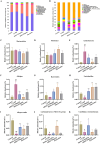Morinda officinalis oligosaccharides alleviate chronic unpredictable mild stress-induced depression through the BDNF/TrkB/CREB pathway and symptoms of sexual dysfunction in mice
- PMID: 39844852
- PMCID: PMC11750790
- DOI: 10.3389/fnins.2024.1509543
Morinda officinalis oligosaccharides alleviate chronic unpredictable mild stress-induced depression through the BDNF/TrkB/CREB pathway and symptoms of sexual dysfunction in mice
Abstract
Background: In recent years, depression has become a global public health concern, and one of the common concomitant symptoms are diminished sexual motivation and impaired sexual performance. The aim of this study was to investigate the potential effects of Morinda officinalis oligosaccharides (MOO) on depression and its concomitant symptom, sexual dysfunction.
Methods: Chronic unpredictable mild stress (CUMS)-induced depression model was constructed, and the effects of MOO on depression and sexual abilities were evaluated.
Results: The results revealed that MOO was able to alleviate CUMS-induced depression-like behavior in mice, to inhibit hippocampal neuron apoptosis, to reverse monoamine neurotransmitter imbalance, increase Brain-derived neurotrophic factor (BDNF) expression levels in the hippocampus, to modulate the composition and distribution of gut microbiota, and to increase the abundance of probiotics after continuous gavage of MOO for 28 days. MOO further confirmed that sexual dysfunction is closely related to the development of depression by improving the lack of sexual motivation and low sexual performance in CUMS-induced depressed mice, modulating the disruption of sex hormone secretion in serum, and alleviating sperm morphology and functional defects in the epididymis.
Conclusion: These findings on MOO provide a basis for exploring its antidepressant mechanism, its use to improve hypogonadotropic symptoms, and for future development of new antidepressant drug to improves hypogonadotropic symptoms.
Keywords: BDNF/TrkB/CREB pathway; CUMS; Morinda officinalis oligosaccharides; depression; gut microbiota; sexual dysfunction.
Copyright © 2025 He, Hu, Wang, Zuo, Li, Zhao, Hao, Dai, Wang and Sun.
Conflict of interest statement
ZZu, HL, and ZZh were employed by Beijing Tongrentang Company Limited. The remaining authors declare that the research was conducted in the absence of any commercial or financial relationships that could be construed as a potential conflict of interest.
Figures








Similar articles
-
Zhi-Zi-Hou-Po decoction alleviates depressive-like behavior and promotes hippocampal neurogenesis in chronic unpredictable mild stress induced mice via activating the BDNF/TrkB/CREB pathway.J Ethnopharmacol. 2024 Jan 30;319(Pt 3):117355. doi: 10.1016/j.jep.2023.117355. Epub 2023 Oct 27. J Ethnopharmacol. 2024. PMID: 37890805
-
BDNF-GSK-3β-β-Catenin Pathway in the mPFC Is Involved in Antidepressant-Like Effects of Morinda officinalis Oligosaccharides in Rats.Int J Neuropsychopharmacol. 2017 Jan 1;20(1):83-93. doi: 10.1093/ijnp/pyw088. Int J Neuropsychopharmacol. 2017. PMID: 27729466 Free PMC article.
-
Loganin improves chronic unpredictable mild stress-induced depressive-like behaviors and neurochemical dysfunction.J Ethnopharmacol. 2023 May 23;308:116288. doi: 10.1016/j.jep.2023.116288. Epub 2023 Feb 19. J Ethnopharmacol. 2023. PMID: 36809822
-
Fructo-oligosaccharides from Morinda officinalis remodeled gut microbiota and alleviated depression features in a stress rat model.Phytomedicine. 2020 Feb;67:153157. doi: 10.1016/j.phymed.2019.153157. Epub 2019 Dec 23. Phytomedicine. 2020. PMID: 31896054
-
Morinda officinalis oligosaccharides increase serotonin in the brain and ameliorate depression via promoting 5-hydroxytryptophan production in the gut microbiota.Acta Pharm Sin B. 2022 Aug;12(8):3298-3312. doi: 10.1016/j.apsb.2022.02.032. Epub 2022 Mar 3. Acta Pharm Sin B. 2022. PMID: 35967282 Free PMC article.
References
-
- Buchenauer L., Haange S., Bauer M., Rolle-Kampczyk U., Wagner M., Stucke J., et al. . (2023). Maternal exposure of mice to glyphosate induces depression- and anxiety-like behavior in the offspring via alterations of the gut-brain axis. Sci. Total Environ. 905:167034. doi: 10.1016/j.scitotenv.2023.167034, PMID: - DOI - PubMed
LinkOut - more resources
Full Text Sources

